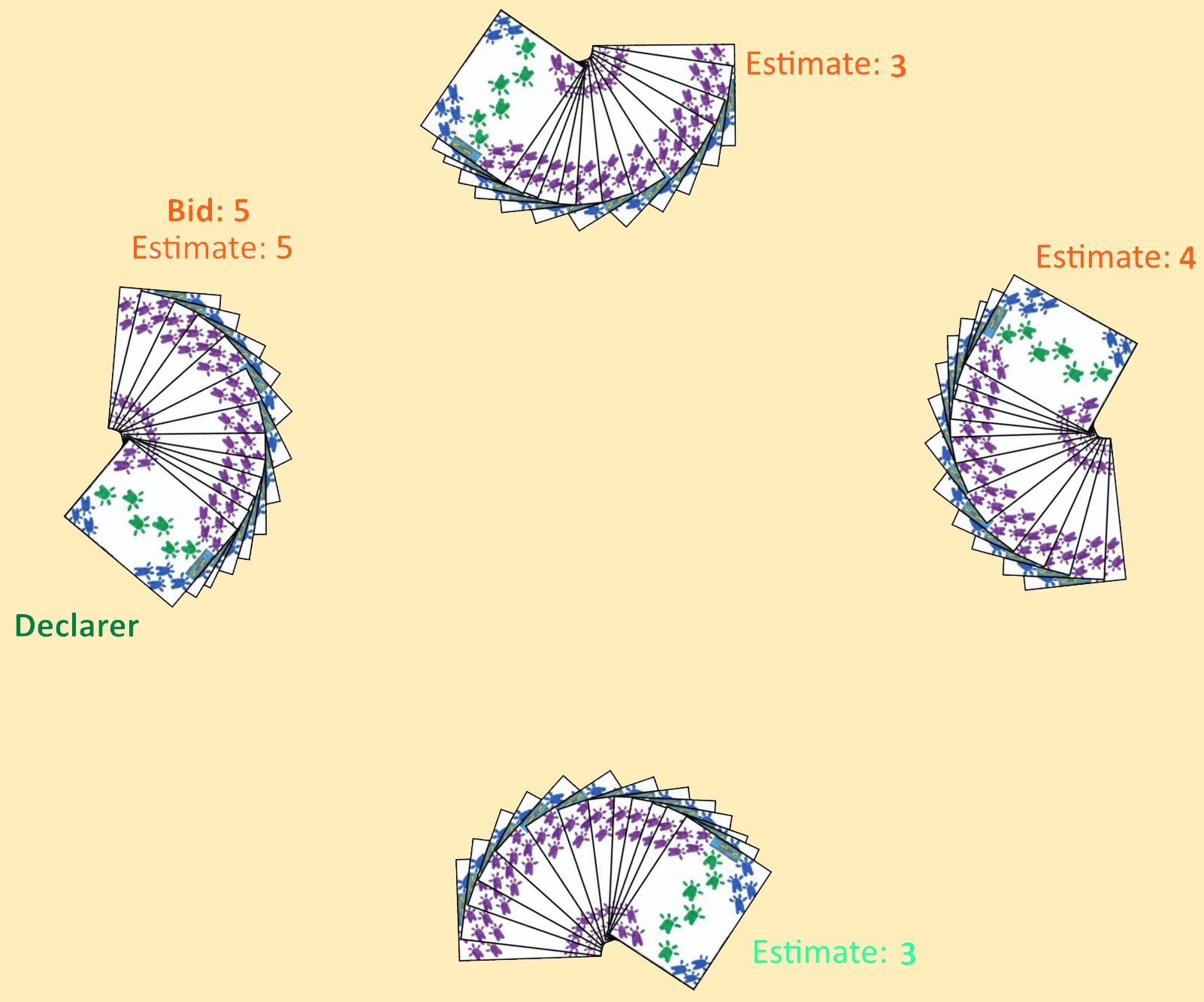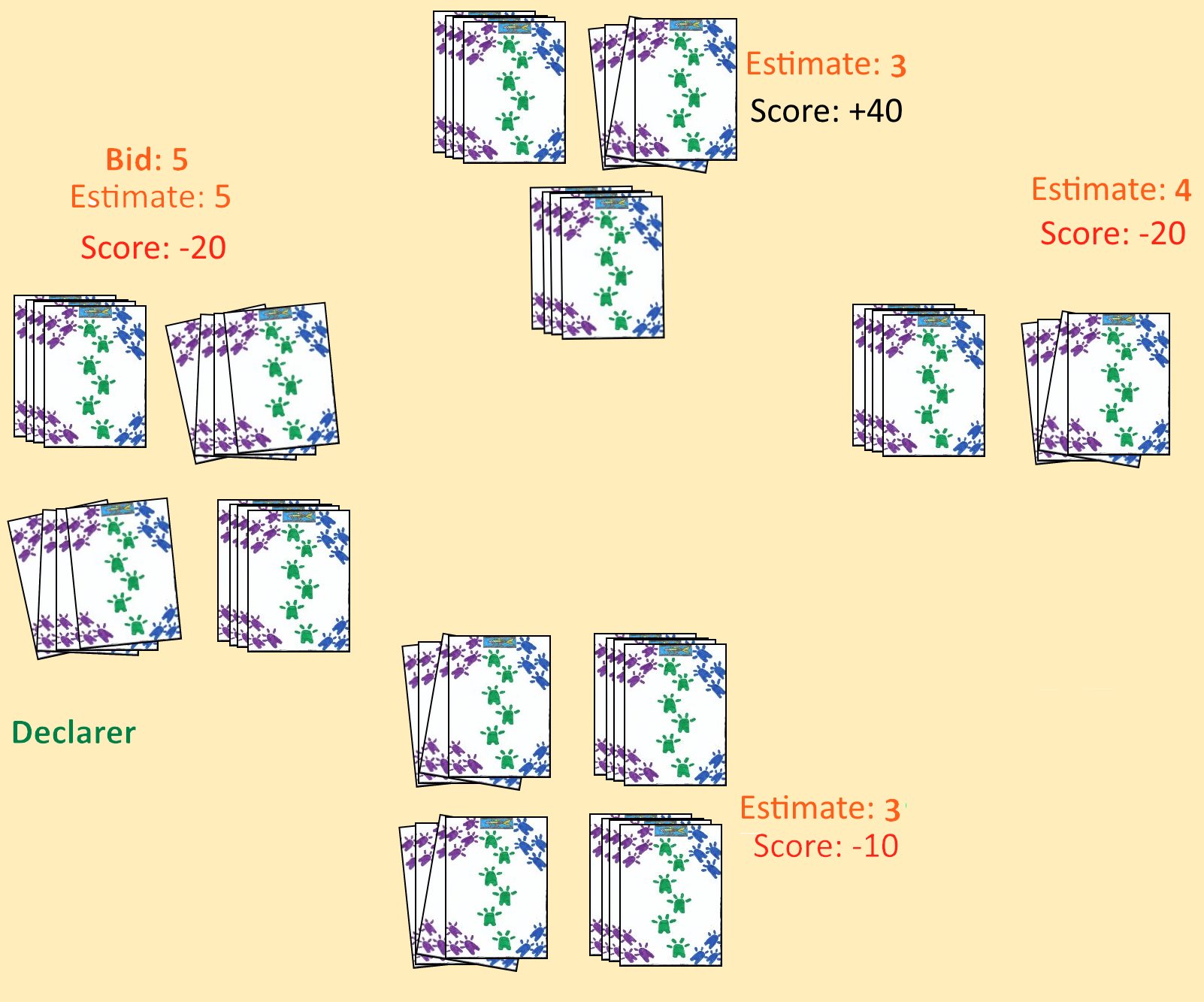| Hand or Round | Trump Suit for the Round |
|---|---|
| 1 to 13 | As per high bid |
| 14 | No Trump |
| 15 | Spades |
| 16 | Hearts |
| 17 | Diamonds |
| 18 | Clubs |

How to Play Estimation |
 Once the hand's have been dealt the players then pick up their hands to begin the bidding for the hand. Before bidding, however, if a player is dealt a hand that contains no cards of one or more suits, he must declare this. At his option, he may also request that all the cards be thrown in, reshuffled and a new hand dealt by the next dealer. No scoring occurs on the hand and the hand does not count as one of the 18 which will be played during the game. The player to the immediate right of the dealer makes the first bid. Each player makes exactly one bid in a clockwise direction. A player's bid is his declaration of the number of tricks he believes he can win during the hand. The
minimum bid is 4 unless a player makes a Dash call (a bid in which the bidder intends to win no tricks, to be described later). He also names a trump suit he intends to use for the hand. A player may also make his bid in "No Trump" indicating he intends to play the hand with no trump suit used. A player may also opt to make a bid of "Dash" (called a Dash Call or Dash Bid) which indicates he intends to win no tricks during the hand with no trump suit used. No more than two players may make a "Dash" bid during the same hand. Thus, if two previous Dash bids have been made no other player may declare a dash bid during the current hand. The bidding continues until each player has had one opportunity to make a bid.
Once the hand's have been dealt the players then pick up their hands to begin the bidding for the hand. Before bidding, however, if a player is dealt a hand that contains no cards of one or more suits, he must declare this. At his option, he may also request that all the cards be thrown in, reshuffled and a new hand dealt by the next dealer. No scoring occurs on the hand and the hand does not count as one of the 18 which will be played during the game. The player to the immediate right of the dealer makes the first bid. Each player makes exactly one bid in a clockwise direction. A player's bid is his declaration of the number of tricks he believes he can win during the hand. The
minimum bid is 4 unless a player makes a Dash call (a bid in which the bidder intends to win no tricks, to be described later). He also names a trump suit he intends to use for the hand. A player may also make his bid in "No Trump" indicating he intends to play the hand with no trump suit used. A player may also opt to make a bid of "Dash" (called a Dash Call or Dash Bid) which indicates he intends to win no tricks during the hand with no trump suit used. No more than two players may make a "Dash" bid during the same hand. Thus, if two previous Dash bids have been made no other player may declare a dash bid during the current hand. The bidding continues until each player has had one opportunity to make a bid.
|

|
 Scoring: Each player earns a score for the hand only if he was able to win exactly (no more and no less) tricks then he declared as his estimation (including the high bidder). If he manages to do this, the number of tricks estimated (and also won) is added to his current score. If the player wins fewer or more tricks than bid, he instead subtracts from his current score the difference between his bid and the number of tricks he actually won. If no player managed to win his exact number of tricks as estimated during the hand, no score occurs for this hand and all scores for the next hand are doubled. In addition, there are a number of bonus or extra points that a player can earn during the hand (a player who successfully estimates his number of tricks will always fit into exactly one of these bonus scoring criteria):
Scoring: Each player earns a score for the hand only if he was able to win exactly (no more and no less) tricks then he declared as his estimation (including the high bidder). If he manages to do this, the number of tricks estimated (and also won) is added to his current score. If the player wins fewer or more tricks than bid, he instead subtracts from his current score the difference between his bid and the number of tricks he actually won. If no player managed to win his exact number of tricks as estimated during the hand, no score occurs for this hand and all scores for the next hand are doubled. In addition, there are a number of bonus or extra points that a player can earn during the hand (a player who successfully estimates his number of tricks will always fit into exactly one of these bonus scoring criteria):